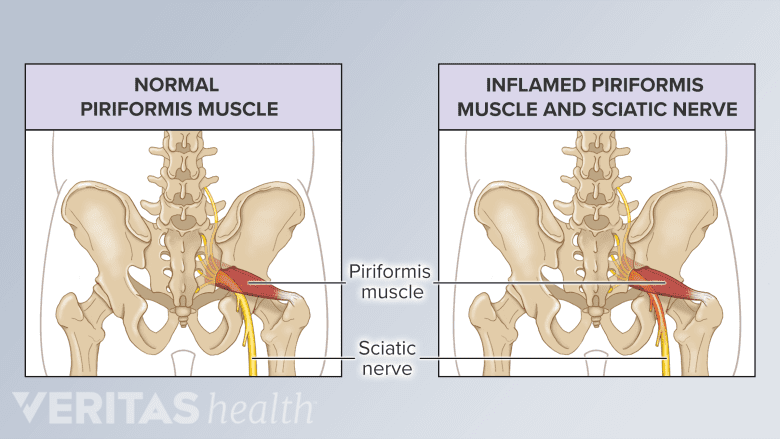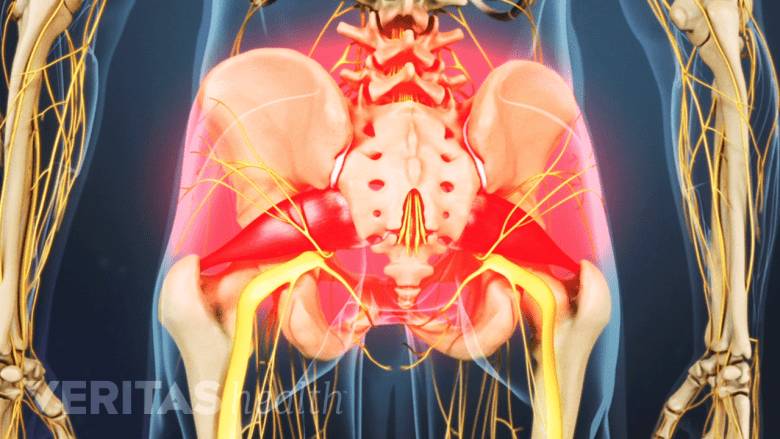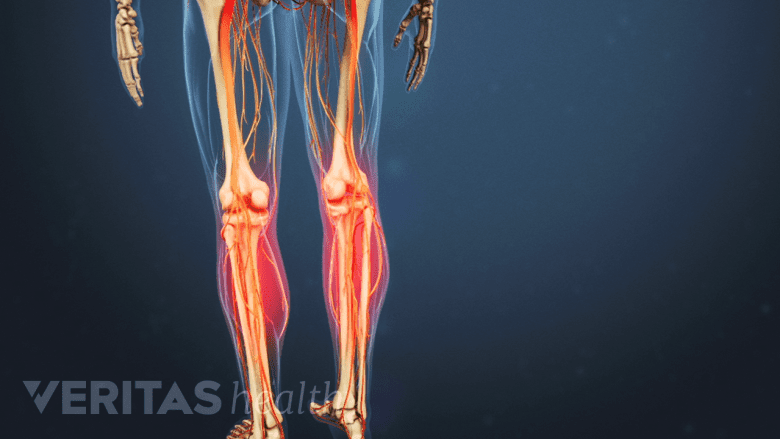Piriformis syndrome is a condition in which the piriformis muscle, located deep in the buttock, spasms and causes buttock pain. The piriformis muscle can also irritate the nearby sciatic nerve and cause pain, numbness, and tingling along the back of the thigh and leg (similar to sciatica).1Probst D, Stout A, Hunt D. Piriformis Syndrome: A Narrative Review of the Anatomy, Diagnosis, and Treatment. PM & R, 11 Suppl 1. https://doi.org/10.1002/PMRJ.12189
In This Article:
Piriformis Syndrome: Hallmark Symptoms and Signs
Research suggests that up to 17% of patients with chronic low back pain and leg pain have piriformis syndrome.2Fahmi A, Rahmadhan MA, Aprianto DR, Subianto H, Turchan A. Complete resolution of recurrent piriformis syndrome after piriformis resection with 3 years’ follow up: A case report. International Journal of Surgery Case Reports. 2020;77:576-579. doi:10.1016/j.ijscr.2020.11.099 The classic symptoms of piriformis syndrome include3Hicks BL, Lam JC, Varacallo M. Piriformis Syndrome. [Updated 2022 Sep 4]. In: StatPearls [Internet]. Treasure Island (FL): StatPearls Publishing; 2022 Jan-. Available from: https://www.ncbi.nlm.nih.gov/books/NBK448172/:
- Sharp, shooting, burning, or aching pain in the buttock
- Pain that travels down the back of the thigh and leg
- Numbness, tingling, or weakness in the buttock and/or leg
Piriformis syndrome symptoms typically affect one side of the body and flare up through prolonged sitting and activities that involve hip movements, such as walking, climbing stairs, or twisting. Pressing the affected buttock with firm pressure may also elicit pain and tenderness.3Hicks BL, Lam JC, Varacallo M. Piriformis Syndrome. [Updated 2022 Sep 4]. In: StatPearls [Internet]. Treasure Island (FL): StatPearls Publishing; 2022 Jan-. Available from: https://www.ncbi.nlm.nih.gov/books/NBK448172/ Piriformis syndrome may sometimes be referred to as Deep Gluteal Syndrome, an all-inclusive term for the entrapment of nerves in the deep gluteal space.4Hernando MF, Cerezal L, Pérez-Carro L, Abascal F, Canga A. Deep gluteal syndrome: anatomy, imaging, and management of sciatic nerve entrapments in the subgluteal space. Skeletal Radiol. 2015;44(7):919-934. http://doi.org/10.1007/s00256-015-2124-6
The Piriformis Muscle: Location and Functions

The piriformis is a deep buttock muscle.
The piriformis is a small muscle located deep in the center buttock below the large gluteus maximus muscle. The piriformis muscle originates near/just below the lower spine, on the front side of the sacrum; runs across the pelvis; and inserts into the top of the thighbone (femur).5Chang C, Jeno SH, Varacallo M. Anatomy, Bony Pelvis and Lower Limb, Piriformis Muscle. [Updated 2022 Oct 3]. In: StatPearls [Internet]. Treasure Island (FL): StatPearls Publishing; 2022 Jan-. Available from: https://www.ncbi.nlm.nih.gov/books/NBK519497/
Major functions of the piriformis muscle
The piriformis muscle plays an essential role in the movements of the hip and the stability of the pelvis.
- It helps rotate the hip outward when the leg is straightened out and abducts the hip when the leg is flexed (bending the knee). These movements allow the leg to move out to the side, such as while stepping to the side from a standing position or getting out of a car.
- It helps stabilize the hip joint, which is vital for maintaining balance while walking.1Probst D, Stout A, Hunt D. Piriformis Syndrome: A Narrative Review of the Anatomy, Diagnosis, and Treatment. PM & R, 11 Suppl 1. https://doi.org/10.1002/PMRJ.12189
In addition to its role in enabling movement and providing stability, the piriformis muscle helps maintain a supported posture. When the piriformis muscle is weak or imbalanced, it can lead to postural problems, such as an excessive arch in the lower back or a tilted pelvis.2Fahmi A, Rahmadhan MA, Aprianto DR, Subianto H, Turchan A. Complete resolution of recurrent piriformis syndrome after piriformis resection with 3 years’ follow up: A case report. International Journal of Surgery Case Reports. 2020;77:576-579. doi:10.1016/j.ijscr.2020.11.099
Piriformis Syndrome: The Primary Cause of Buttock Pain

Piriformis syndrome can cause buttock, hip, and thigh pain.
The strategic location of the piriformis muscle connecting the lower spine to the pelvis makes it essential to almost every movement of the lower body. If the muscle is overused or directly injured (such as from a fall or blunt trauma), it may become a pain generator in the buttock. Sudden or repetitive trauma to the piriformis muscle can cause it to spasm, tighten, or increase in mass (muscle hypertrophy), causing mild to debilitating buttock pain, which can become chronic over time if left untreated.
Watch Got Buttock Pain? Discover What’s Causing It and How to Fix It Video
Conditions that Mimic Piriformis Syndrome

Distribution of pain in piriformis syndrome and sciatica.
Piriformis syndrome can be mistaken for or mimic symptoms of other conditions that affect the pelvis, lower back, and leg. Common low back conditions with symptoms similar to piriformis syndrome include6Chaitow L, DeLany J. The pelvis. In: Clinical Application of Neuromuscular Techniques, Volume 2. Elsevier; 2011:299-389. http://doi.org/10.1016/B978-0-443-06815-7.00011-5:
- Sciatica: A set of symptoms that includes pain, numbness, and weakness in the lower back, leg, and foot. These symptoms occur due to spinal nerve root compression or irritation from a lumbar herniated disc, spinal stenosis, or sacroiliac joint dysfunction. The sciatic nerve passes through the piriformis muscle, so piriformis syndrome can cause symptoms similar to sciatica.
- Localized nerve compression. The compression of the smaller nerves in the pelvis that run close to the piriformis muscle.
Watch Sciatica Causes and Symptoms Video
It's important to note that these conditions can also coexist with piriformis syndrome. A detailed evaluation and diagnostic tests by a trained physician can help determine the underlying cause of the symptoms.
The Course of Piriformis Syndrome

Piriformis syndrome may cause pain in the buttock and the lower back area.
Piriformis syndrome can cause debilitating pain and discomfort in the buttock, thigh, and leg. In most cases, the symptoms of piriformis syndrome can be effectively managed with nonsurgical treatments, such as physical therapy, stretching exercises, and medications. Research indicates that about 85% of people recover from piriformis syndrome pain with nonsurgical treatments.7Kobbe P, Zelle BA, Gruen GS. Case report : recurrent piriformis syndrome after surgical release. Clin Orthop Relat Res. 2008;466(7):1745-1748. http://doi.org/10.1007/s11999-008-0151-5
How Long Piriformis Syndrome Typically Lasts
Mild piriformis syndrome pain may resolve with rest in 1 to 2 days. If the piriformis muscle is acutely inflamed, irritated, or swollen, the pain may persist for several days or weeks, and more targeted treatment will be necessary to prevent the condition from being chronic.7Kobbe P, Zelle BA, Gruen GS. Case report : recurrent piriformis syndrome after surgical release. Clin Orthop Relat Res. 2008;466(7):1745-1748. http://doi.org/10.1007/s11999-008-0151-5 Most people experience complete resolution of symptoms in 1-3 weeks through a guided and targeted physical therapy program.3Hicks BL, Lam JC, Varacallo M. Piriformis Syndrome. [Updated 2022 Sep 4]. In: StatPearls [Internet]. Treasure Island (FL): StatPearls Publishing; 2022 Jan-. Available from: https://www.ncbi.nlm.nih.gov/books/NBK448172/
If left untreated, deep buttock pain may worsen over time and prolong over a period of 2 years (or more) with a gradual worsening of symptoms in some individuals.8Ro TH, Edmonds L. Diagnosis and Management of Piriformis Syndrome: A Rare Anatomic Variant Analyzed by Magnetic Resonance Imaging. J Clin Imaging Sci. 2018;8:6. Published 2018 Feb 21. doi:10.4103/jcis.JCIS_58_17,9Tonley JC, Yun SM, Kochevar RJ, Dye JA, Farrokhi S, Powers CM. Treatment of an individual with piriformis syndrome focusing on hip muscle strengthening and movement reeducation: a case report. Journal of Orthopaedic & Sports Physical Therapy. 2010;40(2):103-111. http://doi.org/10.2519/jospt.2010.3108
When Piriformis Syndrome Is Serious

Symptoms such as severe weakness in the legs and loss of motor functions may indicate a medical emergency.
Specific symptoms of piriformis syndrome may indicate serious medical conditions. These symptoms include, but are not limited to:
- Groin pain and numbness. A dull ache or a sharp, burning, and shooting sensation in the groin area. Some individuals may also feel numbness, which makes it difficult to sit.
- Loss of bowel and bladder control. Difficulty in passing urine or a reduced urinary sensation and/or an inability to control your bowel movements.
These symptoms may indicate a rare, but serious medical condition called cauda equina syndrome, which needs immediate medical attention. Additionally, symptoms such as severe back pain that occur after an accident or trauma, or back pain with fever or unexplained weight loss also warrant prompt medical evaluation.
Watch Cauda Equina Syndrome Video
Piriformis syndrome can develop from a combination of causes and risk factors, and if left untreated, the condition can gradually worsen and become chronic. It is important to consult with a physician to determine the cause of the symptoms and develop an appropriate treatment plan promptly.
- 1 Probst D, Stout A, Hunt D. Piriformis Syndrome: A Narrative Review of the Anatomy, Diagnosis, and Treatment. PM & R, 11 Suppl 1. https://doi.org/10.1002/PMRJ.12189
- 2 Fahmi A, Rahmadhan MA, Aprianto DR, Subianto H, Turchan A. Complete resolution of recurrent piriformis syndrome after piriformis resection with 3 years’ follow up: A case report. International Journal of Surgery Case Reports. 2020;77:576-579. doi:10.1016/j.ijscr.2020.11.099
- 3 Hicks BL, Lam JC, Varacallo M. Piriformis Syndrome. [Updated 2022 Sep 4]. In: StatPearls [Internet]. Treasure Island (FL): StatPearls Publishing; 2022 Jan-. Available from: https://www.ncbi.nlm.nih.gov/books/NBK448172/
- 4 Hernando MF, Cerezal L, Pérez-Carro L, Abascal F, Canga A. Deep gluteal syndrome: anatomy, imaging, and management of sciatic nerve entrapments in the subgluteal space. Skeletal Radiol. 2015;44(7):919-934. http://doi.org/10.1007/s00256-015-2124-6
- 5 Chang C, Jeno SH, Varacallo M. Anatomy, Bony Pelvis and Lower Limb, Piriformis Muscle. [Updated 2022 Oct 3]. In: StatPearls [Internet]. Treasure Island (FL): StatPearls Publishing; 2022 Jan-. Available from: https://www.ncbi.nlm.nih.gov/books/NBK519497/
- 6 Chaitow L, DeLany J. The pelvis. In: Clinical Application of Neuromuscular Techniques, Volume 2. Elsevier; 2011:299-389. http://doi.org/10.1016/B978-0-443-06815-7.00011-5
- 7 Kobbe P, Zelle BA, Gruen GS. Case report : recurrent piriformis syndrome after surgical release. Clin Orthop Relat Res. 2008;466(7):1745-1748. http://doi.org/10.1007/s11999-008-0151-5
- 8 Ro TH, Edmonds L. Diagnosis and Management of Piriformis Syndrome: A Rare Anatomic Variant Analyzed by Magnetic Resonance Imaging. J Clin Imaging Sci. 2018;8:6. Published 2018 Feb 21. doi:10.4103/jcis.JCIS_58_17
- 9 Tonley JC, Yun SM, Kochevar RJ, Dye JA, Farrokhi S, Powers CM. Treatment of an individual with piriformis syndrome focusing on hip muscle strengthening and movement reeducation: a case report. Journal of Orthopaedic & Sports Physical Therapy. 2010;40(2):103-111. http://doi.org/10.2519/jospt.2010.3108

